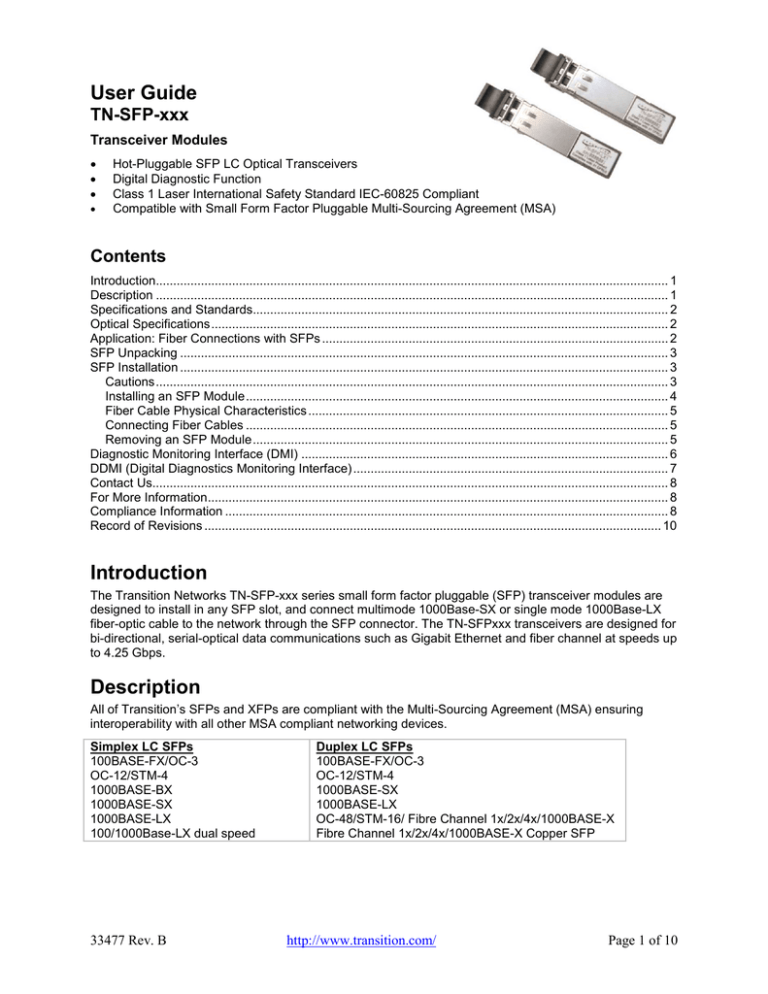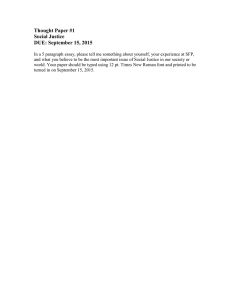
User Guide
TN-SFP-xxx
Transceiver Modules
•
•
•
•
Hot-Pluggable SFP LC Optical Transceivers
Digital Diagnostic Function
Class 1 Laser International Safety Standard IEC-60825 Compliant
Compatible with Small Form Factor Pluggable Multi-Sourcing Agreement (MSA)
Contents
Introduction.................................................................................................................................................... 1
Description .................................................................................................................................................... 1
Specifications and Standards........................................................................................................................ 2
Optical Specifications .................................................................................................................................... 2
Application: Fiber Connections with SFPs .................................................................................................... 2
SFP Unpacking ............................................................................................................................................. 3
SFP Installation ............................................................................................................................................. 3
Cautions .................................................................................................................................................... 3
Installing an SFP Module .......................................................................................................................... 4
Fiber Cable Physical Characteristics ........................................................................................................ 5
Connecting Fiber Cables .......................................................................................................................... 5
Removing an SFP Module ........................................................................................................................ 5
Diagnostic Monitoring Interface (DMI) .......................................................................................................... 6
DDMI (Digital Diagnostics Monitoring Interface) ........................................................................................... 7
Contact Us..................................................................................................................................................... 8
For More Information ..................................................................................................................................... 8
Compliance Information ................................................................................................................................ 8
Record of Revisions .................................................................................................................................... 10
Introduction
The Transition Networks TN-SFP-xxx series small form factor pluggable (SFP) transceiver modules are
designed to install in any SFP slot, and connect multimode 1000Base-SX or single mode 1000Base-LX
fiber-optic cable to the network through the SFP connector. The TN-SFPxxx transceivers are designed for
bi-directional, serial-optical data communications such as Gigabit Ethernet and fiber channel at speeds up
to 4.25 Gbps.
Description
All of Transition’s SFPs and XFPs are compliant with the Multi-Sourcing Agreement (MSA) ensuring
interoperability with all other MSA compliant networking devices.
Simplex LC SFPs
100BASE-FX/OC-3
OC-12/STM-4
1000BASE-BX
1000BASE-SX
1000BASE-LX
100/1000Base-LX dual speed
33477 Rev. B
Duplex LC SFPs
100BASE-FX/OC-3
OC-12/STM-4
1000BASE-SX
1000BASE-LX
OC-48/STM-16/ Fibre Channel 1x/2x/4x/1000BASE-X
Fibre Channel 1x/2x/4x/1000BASE-X Copper SFP
http://www.transition.com/
Page 1 of 10
Transition Networks
TN-SFP-xxx User Guide
Specifications and Standards
The TN-SFP-xxx was designed to meet these standards and specifications:
Standards
IEEE 802.3 2003; ANSI X3.297-1997
Compliance
Dimensions
Power
Power Consumption
Environment
Shipping
Weight
Voltage
IEC-60825; FDA 21; CFR 1040.10 and 1040.11
Width: 0.52" [13 mm] x Depth: 2.18" [55 mm] x Height: 0.33" [8 mm]
3.3V
0.66 watts
0°C – 70°C
Operating Temp
Operating Temp
Operating Temp
Operating Temp
Storage
Temp
Warranty
1 lb. (454 g) approximately
3.3 volts
TN-SFP-SX TN-SFP-SXD, TN-SFP-LX1 TN-SFP-ESX5 , TN-SFP-OC3S3 ,
TN-SFP-ESX6, TN-SFP-FC2XM, TN-SFP-FC2XS2: -10°C – 85°C
TN-SFP-ELX1 TN-SFP-LX3 TN-SFP-LX5, TN-SFP-LX8 TN-SFP-LX12,
TN-SFP-OCx TN-SFP-LX16, TN-SFP-FC2XS40 TN-SFP-FC2XS15,
TN-SFP-TX TN-SFP-T-MG: 0°C – 70°C
TN-SFP-STM1E: -20°C – 85°C
TN-SFP-LX1T, TN-SFP-LX3T, TN-SFP-LXB11T, TN-SFP-LXB12T,
TN-SFP-LXB21T, & TN-SFP-LXB22T: -40°C to 85°C
-40°C to 85°C (-40° to 185°F)
Lifetime
Transition Networks' SFP modules fully comply with Multi-Sourcing Agreement (MSA). This compliance
allows our SFP modules to be used in other MSA compliant SFP platforms without any problems.
Optical Specifications
The Optical Spec for all Transition Networks’ SFPs are listed at www.transition.com/sfp.pdf.
Application: Fiber Connections with SFPs
SFPs are used with Gigabit Ethernet Switches and Routers, Fibre Channel Switch Infrastructure, xDSL
applications, Metro Edge Switching, etc.
33477 Rev. B
www.transition.com/
Page 2 of 10
Transition Networks
TN-SFP-xxx User Guide
SFP Unpacking
Before you start installing the TN-10G-SFP-xxx, verify that the package contains the following items:
o
o
o
One TN-10G-SFP-xxx
Two protective foam pieces
One Documentation Postcard
Notify your sales representative immediately if any of the aforementioned items is missing or damaged.
Save the packaging for possible future use.
SFP Installation
Cautions
•
•
•
•
The SFP tranceiver module is keyed to only be installed one way. However, if forced the wrong way,
damage may occur.
Avoid getting dust or other contaminants into the fiber bore of the SFP transceiver module, as this will
cause the optics to not operate properly.
Clean the optic surfacees of the optical fiber before you plug them back in to the optical bores of
another SFP tranceiver module.
Each port must match the wavelength specifications on the other end of the cable, and the cable
must not exceed the specified cable length for reliable communications.
33477 Rev. B
www.transition.com/
Page 3 of 10
Transition Networks
TN-SFP-xxx User Guide
Installing an SFP Module
1. Attach an ESD-preventive wrist strap to your wrist and to the ESD ground connector or a bare metal
surface on your chassis.
2. Remove the SFP transceiver module from its protective packaging. Note: Do not remove the optical
bore dust plugs until directed to do so in a later procedure.
3. Check the slot orientation. Note that for some devices (e.g., S4224) some slots are “upside down”
compared to other slots.
4. Position the SFP device at the desired installation slot, with the label facing correctly.
5. Carefully slide the SFP device into the slot, aligning it with the internal installation guides.
Switch
Switch
Label side top
of SFP module
Bale
Clasp
Triangle
indicates bottom
of SFP cage
SFP Module
Fully Inserted SFP
6. Ensure that the SFP device is firmly seated against the internal mating connector. To verify that the
SFP is seated and latched properly:.
a) Grasp the SFP by the sides and try to remove it without releasing the latch.
b) If the SFP can not be removed, it is installed and seated properly. If the SFP can be removed,
reinsert it and press harder with your thumb; repeat if necessary until it is latched securely into the
socket.
7. Connect the fiber cable to the fiber port connector of the SFP device. Make sure the SFP release
latch is in the up (closed) position when you insert the cable connector into the SFP.
8. Remove the dust plug from the connector. Save the dust plug for future use.
9. Attach an appropriate cable into the SFP module port.
10. Attach the other end of the cable into the other device.
11. Observe the status LED(s). See the related manual for details.
33477 Rev. B
www.transition.com/
Page 4 of 10
Transition Networks
TN-SFP-xxx User Guide
Fiber Cable Physical Characteristics
The fiber cable physical characteristics must meet or exceed IEEE 802.3ae specifications:
• Single mode fiber (recommended): 9 μm
• Multimode fiber (recommended):
62.5/125 μm
• Multimode fiber (optional):
100/140, 85/140, 50/125 μm
Warning: Visible and invisible laser radiation when open. DO NOT stare into laser beam or view directly
with optical instruments. Failure to observe this warning could result in damage to your eyes or blindness.
Connecting Fiber Cables
To install the fiber cable, do the following:
1. Locate the appropriate fiber cable.
2. Install the cable as shown below.
Removing an SFP Module
Caution: Be careful when removing the SFP or SFP+ from a device. Some SFP transceiver module
temperatures may exceed 160°F (70°C) and be too hot to touch with bare hands. Note: • Do not remove
and replace the SFP modules more often than necessary; excessive SFP removing and replacing can
shorten the SFPs useful life.
1. Attach an ESD-preventive wrist strap to your wrist and to the ESD ground connector or a bare metal
surface on your chassis.
2. For future reattachment of fiber-optic cables, note which connector plug is send (TX) and which is
receive (RX).
3. Remove the SFP transceiver module:
a. If the SFP transceiver module has an actuator button latch, gently press the actuator button on
the front of the SFP transceiver module until it clicks and the latch mechanism releases the SFP
transceiver module from the socket connector. Grasp the actuator button between your thumb and
index finger, and carefully pull the SFP transceiver module straight out of the module slot.
b. If the SFP transceiver module has a bail clasp latch, pull the latch out and down to eject the SFP
transceiver module from the socket connector. If the bail clasp latch is obstructed and you cannot use
your index finger to open it, use a small, flat-blade screwdriver or other long, narrow instrument to
open the bail clasp latch. Grasp the SFP transceiver module between your thumb and index finger,
and carefully remove it from the socket.
4. Replace the Dust Plug.
5. Place the removed SFP/SFP+ transceiver module in an antistatic bag or other protective package.
33477 Rev. B
www.transition.com/
Page 5 of 10
Transition Networks
TN-SFP-xxx User Guide
Diagnostic Monitoring Interface (DMI)
The following DMI port screen and explanation table contains brief definitions of the DMI support offered
on some (SFP Transceiver Modules. For further information, see the help option on the CPSMM-xxx,
SNMP agent, or Transition Networks Focal Point or ION System GUI. Note: This feature is not available
on all devices and may vary between products. See the related manual for more information.
DMI Parameter
DMI Rx Power
DMI Rx Power
Alarm
DMI Temp
DMI Temp Alarm
DMI Bias Current
DMI Bias Alarm
DMI Tx Power
DMI Tx Power Alarm
Rx Power Intrusion
Threshold
Description
Measured receive optical power in microwatts and in decibels relative to 1mW.
Alarm status of measured receive optical power.
Internally measured temperature of transceiver in degrees Celsius and degrees
Farenheit.
Alarm status for internally measured temperature of the transceiver.
Measured transmit bias current in microamperes.
Alarm status for measured transmit bias current for the interface.
Measured transmit power in microwatts and in decibels relative to 1mW.
Alarm status of measured transmit power.
Tells the converter to stop passing traffic when the receive power drops below
the new threshold. This feature is sometimes referred to as 'Intrusion Detection,'
since tapping into a fiber to intercept traffic leads to a reduction in receive power.
This value can be entered in microwatts or in decibels relative to 1mW.
TN-SFP distances, TX power, RX power, and link budgets can be found on Transition Netwoks’ website,
document “SFP/XFP Fiber and Copper Connectors.” See at www.transition.com.
The fiber optic transmitters on this device meet Class I Laser safety requirements per IEC-825/CDRH
standards and comply with 21 CFR1040.10 and 21CFR1040.11.
WARNING: Visible and invisible laser radiation when open. Do not stare into the beam or view the beam
directly with optical instruments. Failure to observe this warning could result in an eye injury or blindness.
IMPORTANT: Copper based media ports such as Twisted Pair (TP) Ethernet, USB, RS232, RS422,
RS485, DS1, DS3, Video Coax, etc., are intended to be connected to intra-building (inside plant) link
segments that are not subject to lightening transients or power faults. Copper-based media ports such as
Twisted Pair (TP) Ethernet, USB, RS232, RS422, RS485, DS1, DS3, Video Coax, etc., are NOT to be
connected to inter-building (outside plant) link segments that are subject to lightening transients or power
faults.
33477 Rev. B
www.transition.com/
Page 6 of 10
Transition Networks
TN-SFP-xxx User Guide
DDMI (Digital Diagnostics Monitoring Interface)
DDMI (Digital Diagnostics Monitoring Interface) provides enhanced digital DMI for optical transceivers
which allows real time access to device operating parameters.
The following DMI port screen and explanation table contains brief definitions of the DDMI support offered
on some Small Form Factor Pluggable (SFP) Transceiver Modules. For further information, see the help
option or User Guide for the S3290, S4140, S4212, and S4224. Note: This feature is not available on all
devices and may vary between products. See the related manual for more information.
The Transceiver Information and DDMI Information sections are described below.
DDMI Parameter
Description
DMI
Rx Power (uW) Intrusion Threshold; a level for Rx Power on the Fiber port. If
the DMI read value falls below the preset value, an intrusion is detected, and a
trap is generated. The default is 0 uW. The range is 0 - 65,535 uW.
Port
The device’s port number.
Vendor
The SFP vendor’s name (e.g., Transition).
Part Number
The SFP vendor Part number provided by the SFP vendor (TN-10GSFP-SR).
Serial Number
The SFP Vendor Serial number provided by the SFP vendor (e.g., 8672105).
Revision
The SFP vendor Revision level for part number provided by the SFP vendor.
Data Code
The vendor's manufacturing date code (e.g., 2011-08-09).
Transeiver
The Transceiver compatibility (e.g., 1000BASE_SX or 10G).
Current
The current value of temperature, voltage, TX bias, TX power, and RX power.
High Alarm Threshold
The high alarm threshold value of temperature, voltage, TX bias, TX power,
and RX power.
High Warn Threshold
The high warn threshold value of temperature, voltage, TX bias, TX power,
and RX power.
Low Warn Threshold
The low warn threshold value of temperature, voltage, TX bias, TX power, and
RX power.
Low Alarm Threshold
The low alarm threshold value of temperature, voltage, TX bias, TX power,
and RX power.
33477 Rev. B
www.transition.com/
Page 7 of 10
Transition Networks
TN-SFP-xxx User Guide
Contact Us
Technical Support
Technical support is available 24-hours a day
US and Canada: 1-800-260-1312
International: 00-1-952-941-7600
Transition Now
Chat live via the Web with Transition Networks Technical Support.
Log onto www.transition.com and click the Transition Now link.
Web-based Seminars
Transition Networks provides seminars via live web-based training.
Log onto www.transition.com and click the Learning Center link.
E-Mail
Ask a question anytime by sending an e-mail to our technical support staff.
techsupport@transition.com
Address
Transition Networks
10900 Red Circle Drive
Minnetonka, MN 55343, U.S.A.
Telephone:
952-941-7600
Toll free:
800-526-9267
Fax:
952-941-2322
For More Information
Technical information in this document is subject to change without notice. For more information see the
TN SFP Line Card or the SFP/XFP Landing page.
Compliance Information
Class I Laser Compliance
This product has been tested and found to comply with the limits for FDA Class I laser for IEC60825,
EN60825, and 21CFR1040 specifications.
Translated Safety Warnings
Warning Class I laser product.
Waarschuwing Klasse-I laser produkt.
Varoitus Luokan I lasertuote.
Attention Produit laser de classe I
Warnung Laserprodukt der Klasse I.
Avvertenza Prodotto laser di Classe I.
33477 Rev. B
Advarsel Laserprodukt av klasse I.
Aviso Produto laser de classe I.
¡Advertencia! Producto láser Clase I.
Varning! Laserprodukt av klass I.
Aviso Produto a laser de classe I.
Advarsel Klasse I laserprodukt.
www.transition.com/
Page 8 of 10
Transition Networks
TN-SFP-xxx User Guide
FCC Regulations
This equipment has been tested and found to comply with the limits for a Class A digital device, pursuant
to Part 15 of the FCC rules. These limits are designed to provide reasonable protection against harmful
interference when the equipment is operated in a commercial environment. This equipment generates,
uses and can radiate radio frequency energy and, if not installed and used in accordance with the
instruction manual, may cause harmful interference to radio communications.
Operation of this equipment in a residential area is likely to cause harmful interference, in which case the
user will be required to correct the interference at the user's own expense.
Canadian Regulations
This digital apparatus does not exceed the Class A limits for radio noise for digital apparatus set out on
the radio interference regulations of the Canadian Department of Communications.
Le présent appareil numérique n'émet pas de bruits radioélectriques dépassant les limites applicables
aux appareils numériques de la Class A prescrites dans le Règlement sur le brouillage radioélectrique
édicté par le ministère des Communications du Canada.
European Regulations
Warning
This is a Class A product. In a domestic environment this product may cause radio interference in which
case the user may be required to take adequate measures.
Achtung !
Dieses ist ein Gerät der Funkstörgrenzwertklasse A. In Wohnbereichen können bei Betrieb dieses
Gerätes Rundfunkstörungen auftreten. In diesem Fäll is der Benutzer für Gegenmaßnahmen
verantwortlich.
Attention !
Ceci est un produit de Classe A. Dans un environment domestique, ce produit risque de créer des
interférences radioélectriques, il appartiendra alors à l'utilsateur de prende les measures
spécifiques appropriées.
In accordance with European Union Directive 2002/96/EC of the European Parliament and
of the Council of 27 January 2003, Transition Networks will accept post usage returns of
this product for proper disposal. The contact information for this activity can be found in the 'Contact Us'
portion of this document.
Der Anschluss dieses Gerätes an ein öffentlickes Telekommunikationsnetz in den EGMitgliedstaaten
verstösst gegen die jeweligen einzelstaatlichen Gesetze zur Anwendung der Richtlinie 91/263/EWG zur
Angleichung der Rechtsvorschriften der Mitgliedstaaten über Telekommunikationsendeinrichtungen
einschliesslich der gegenseitigen Anerkennung ihrer Konformität.
CAUTION: RJ connectors are NOT INTENDED FOR CONNECTION TO THE PUBLIC
TELEPHONE NETWORK. Failure to observe this caution could result in damage to the
public telephone network.
Der Anschluss dieses Gerätes an ein öffentlickes Telekommunikationsnetz in den EGMitgliedstaaten
verstösst gegen die jeweligen einzelstaatlichen Gesetze zur Anwendung der Richtlinie 91/263/EWG zur
Angleichung der Rechtsvorschriften der Mitgliedstaaten über Telekommunikationsendeinrichtungen
einschliesslich der gegenseitigen Anerkennung ihrer Konformität.
33477 Rev. B
www.transition.com/
Page 9 of 10
Transition Networks
TN-SFP-xxx User Guide
Record of Revisions
Rev
Date
Notes
A
9/30/13
Initial release.
B
4/26/16
Revised operating temperatures, updated contact information and format.
Trademarks: All trademarks and registered trademarks are the property of their respective owners.
Copyright restrictions: © 2003-2016 Transition Networks. All rights reserved. No part of this work may be
reproduced or used in any form or by any means - graphic, electronic or mechanical - without written permission from
Transition Networks.
33477 Rev. B
www.transition.com/
Page 10 of 10



